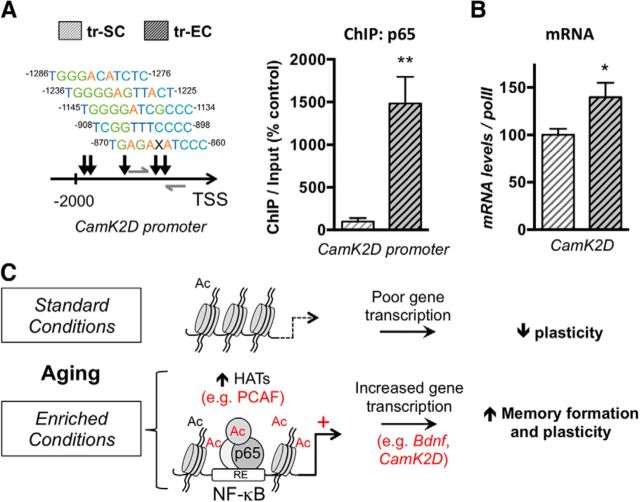Figure 5.
Late-life enrichment induces p65/NF-κB binding at NF-κB sites of spatial training-induced genes. A, ChIP performed with an antibody against p65/NF-κB on chromatin isolated from dorsal hippocampi of SC or EC aged rat groups that were trained in the MWM for 3 d as described. Left, The scheme depicts the rat CamK2D proximal promoter and the potential p65/NF-κB binding sites (“X” represents any of the 4 bases) with their distance relative to the transcription start site (TSS), as found with TRED software. Right, The quantity of immunoprecipitated DNA was assessed by qPCR with specific primers (gray arrows on the scheme). The net quantities of enriched DNA were corrected with their corresponding input DNA. Data are expressed as mean ± SEM (n = 3 per group), with the percentage relative to the tr-SC control group set at 100%. EE promotes p65/NF-κB binding to the proximal region of the rat CamK2D promoter. B, RT-qPCR evaluation of CamK2D transcripts in the dorsal hippocampi of trained groups of aged rats, enriched (EC) or not (SC). Values were normalized to RNA polymerase II expression levels. Data are expressed as mean ± SEM (n = 6 per group), with the percentage relative to the tr-SC control group set at 100%. EE significantly induced CamK2D expression. *p < 0.05; **p < 0.01 (Student's t test to compare the effect of housing on trained aged rats, tr-EC vs tr-SC). C, Proposed model, Animals raised in standard conditions during their whole life present decreased plasticity with aging. EE induces acetylation-related events (in part through increased PCAF expression) and promotes histone (H3) and non-histone (p65/NF-κB) acetylation that leads to increased NF-κB-dependent gene transcription of specific plasticity and memory related genes, such as Bdnf and CamK2D. Ac, Acetylation.

